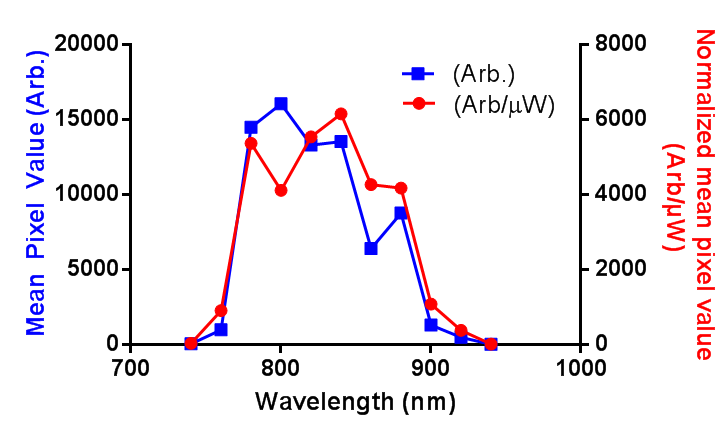In order to successfully combined in vivo 2-photon GCaMP6f imagining and red retrobeads, I need to know the 2-photon excitation spectrum for the beads. I couldn’t find the information online, and the lumafluor didn’t have it, so I produced a rough and ready estimate. First, the power of the laser was measured in the range of 740 to 940 nm, then a small sample of undiluted retrobeads was held in the bottom of a sealed capillary tube, and the mean pixel value of the center of this capillary was measured as the wavelength was changed. I have presented the data as both the raw pixel values (Arb.) and the pixel values normalized to the power at the sample (Arb/µW). Long story short: between 780 and 880 nm is where you want to image.
EDIT: I have adjusted the axis as per the comment. I was just going to use “brightness”, but more descriptive = more better, right?
Thanks for sharing this. The Y-axes are labeled “emission”, by which you mean “total fluorescence emission as measured in your detection pathway”, right? It’s potentially confusing because it’s common to plot a fluorophore’s emission as a function of wavelength, but that’s not what you’re doing here. You’re plotting an indirect measure of the fluorophore’s 2p cross section as a function of wavelength. It’s definitely useful and a good thing to share, but I just thought I’d add this brief note in case anyone might misunderstand the graph and think that red retrobeads emit around 780 – 880 nm.
“You’re plotting an indirect measure of the fluorophore’s 2p cross section as a function of wavelength.” Yes, exactly. Anyway, I’ve updated the axis to hopefully make it unambiguous.
Did you test above 940nM? I’m a little surprised that the peak excitation fluorescence of a red indicator is ~850nM. Rhodamine based dyes have a really strong fluorescence in the range you’ve tested, but they also have another peak >1000nM, which is where you would expect the primary TPE to occur. Thanks for the info!
Hi Charles,
No, the data you see there is all I got. Yes, you’re right, rhodamine based dyes should have a second peak ~>1000 nm. However, the laser power on my Chameleon tales an absolute nose dive much above 920nm, so I didn’t both investigating there.